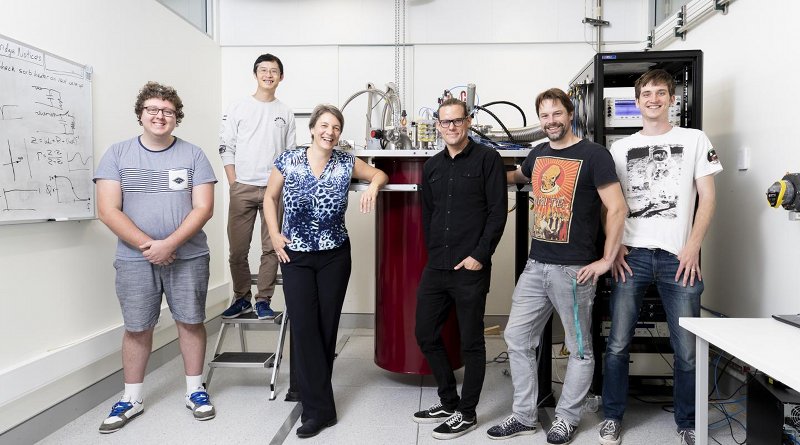200 Times Faster Than Ever Before: The Speediest Quantum Operation Yet
A group of scientists led by 2018 Australian of the Year Professor Michelle Simmons have achieved the first two-qubit gate between atom qubits in silicon – a major milestone on the team’s quest to build an atom-scale quantum computer. The pivotal piece of research was published in world-renowned journal Nature.
A two-qubit gate is the central building block of any quantum computer – and the UNSW team’s version of it is the fastest that’s ever been demonstrated in silicon, completing an operation in 0.8 nanoseconds, which is ~200 times faster than other existing spin-based two-qubit gates.
In the Simmons’ group approach, a two-qubit gate is an operation between two electron spins – comparable to the role that classical logic gates play in conventional electronics. For the first time, the team was able to build a two-qubit gate by placing two atom qubits closer together than ever before, and then – in real-time – controllably observing and measuring their spin states.
The team’s unique approach to quantum computing requires not only the placement of individual atom qubits in silicon but all the associated circuitry to initialise, control and read-out the qubits at the nanoscale – a concept that requires such exquisite precision it was long thought to be impossible. But with this major milestone, the team is now positioned to translate their technology into scalable processors.
Professor Simmons, Director of the Centre of Excellence for Quantum Computation and Communication Technology (CQC2T) and founder of Silicon Quantum Computing Pty Ltd., says the past decade of previous results perfectly set the team up to shift the boundaries of what’s thought to be “humanly possible”.
“Atom qubits hold the world record for the longest coherence times of a qubit in silicon with the highest fidelities,” she says. “Using our unique fabrication technologies, we have already demonstrated the ability to read and initialise single electron spins on atom qubits in silicon with very high accuracy. We’ve also demonstrated that our atomic-scale circuitry has the lowest electrical noise of any system yet devised to connect to a semiconductor qubit.
“Optimising every aspect of the device design with atomic precision has now allowed us to build a really fast, highly accurate two-qubit gate, which is the fundamental building block of a scalable, silicon-based quantum computer.
“We’ve really shown that it is possible to control the world at the atomic scale – and that the benefits of the approach are transformational, including the remarkable speed at which our system operates.”
UNSW Science Dean, Professor Emma Johnston AO, says this key paper further shows just how ground-breaking Professor Simmons’ research is.
“This was one of Michelle’s team’s final milestones to demonstrate that they can actually make a quantum computer using atom qubits. Their next major goal is building a 10-qubit quantum integrated circuit – and we hope they reach that within 3-4 years.”
Getting up and close with qubits – engineering with a precision of just thousand-millionths of a metre
Using a scanning tunnelling microscope to precision-place and encapsulate phosphorus atoms in silicon, the team first had to work out the optimal distance between two qubits to enable the crucial operation.
“Our fabrication technique allows us to place the qubits exactly where we want them. This allows us to engineer our two-qubit gate to be as fast as possible,” says study lead co-author Sam Gorman from CQC2T.
“Not only have we brought the qubits closer together since our last breakthrough, but we have learnt to control every aspect of the device design with sub-nanometer precision to maintain the high fidelities.”
Observing and controlling qubit interactions in real-time
The team was then able to measure how the qubits states evolved in real-time. And, most excitingly, the researchers showed how to control the interaction strength between two electrons on the nano-second timescale.
“Importantly, we were able to bring the qubit’s electrons closer or further apart, effectively turning on and off the interaction between them, a prerequisite for a quantum gate,” says other lead co-author Yu He.
“The tight confinement of the qubit’s electrons, unique to our approach, and the inherently low noise in our system enabled us to demonstrate the fastest two qubit gate in silicon to date.”
“The quantum gate we demonstrated, the so-called SWAP gate, is also ideally suited to shuttle quantum information between qubits – and, when combined with a single qubit gate, allows you to run any quantum algorithm.”
A thing of physical impossibility? Not anymore
Professor Simmons says that this is the culmination of two decades’ worth of work.
“This is a massive advance: to be able to control nature at its very smallest level so that we can create interactions between two atoms but also individually talk to each one without disturbing the other is incredible. A lot of people thought this would not be possible,” she says.
“The promise has always been that if we could control the qubit world at this scale, they would be fast, and they sure are!”

